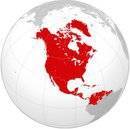Sustainability
A topic that is being widely discussed these days is that of sustainability however when people discuss sustainability just what size of a land area are they hoping to operate on a sustainable basis? Most do not even give any consideration to the size of the area that is to be sustained. Would it be the family home, the neighborhood, some farm, a hamlet, town, city, municipality, a state or province, a country, a continent, our entire planet, our galaxy? Hmmm, obviously attempting to sustain the last in this list of areas is just silly and the second last is, although it is the stuff that dreams are made of, just as silly; so much for the discussions of the proletariat.
In the world of today the only one of the areas listed represents a truly sustainable one that being an area continental in scope and not just any of the earths’ continents only the North American continent has what is required for real, practical, and achievable sustainability. There are sound engineering reasons for this as determined by the scientific community of our Continent some nine decades ago.
Establishment education
Canada offers degrees in Environmental Science sadly most of the courses are electives one result of this is that graduates can come out with little if any common knowledge and although one course is dedicated to sustainable management of resources the course deals with isolated parts of our resource base, such as how to manage fishing or logging or soil. We find it dismaying that no mention is even made of the sustainable management of any given land area? Graduates should be thought of as technologists those who can do a good job of dealing with the microscopic parts of our environment but not as planners since their education does not include the macrocosmic aspect of dealing with our environmental resources.
Those who are involved with the NAU programs are more in tune with the times but they seem to be mostly concerned with how their particular home areas will fare and foremost in their thinking is how that they can gain some advantage for that particular area again not thinking of the big picture. It seems that only the education organization of Technocracy Inc. Est. 1933 teaches social engineering on a sustainable scale that of an entire continent.
Coordination
is vital
between those who understand the Technocratic Continental Social Design
and those now involved in the NAU programs.
Our current environmentally destructive hodge-podge of a social system grew out of working from the minute to the whole, which was fine in the hand tool era but completely wrong in this the machine age with a comparatively high population. We must have a social mechanism designed from the top down such as the one proposed by Technocracy Inc. Est. 1933 of WA State if we are to achieve a sustainable way of life.
TNAT
The North American Technate

NB: One percent of the earths’ population is included
Historical
Note:
Technocracy Inc. Est. 1933 of WA State was the FIRST EVER environmental
organization (see this document it was published in the
1930s) so why not get acquainted with this fine Organization and learn
about how to manage our resources in a TRULY sustainable way. Be informed by a
group that has been environmentally conscious for the past 90 years!
INVESTIGATE TECHNOCRACY
Take this link to a document about water
___________________
End of document
The Energy Survey of North America
In 1919 two things became apparent to the federal
administration of the United States of America One was that due to the technology
installed during World War One America was able to produce more than ever with
a much smaller work force. Machines were doing the work of people on a scale
which had not even been contemplated. Secondly only a small percentage of
people would return to rural America from whence they came. The scientific
community was asked what societal results could be expected. The Continent wide
investigation was directed from Columbia University.
Between 1919 and 1932 the survey also included a “stock taking” of natural resources. It was found that if a part of South America was also included those who dwelt here would have enough of everything they required to carry on life as they were and to have an even better lifestyle in years to come. Yes, this land area is rife with what was needed therefore if it were managed in appropriate ways the citizens could partake of an abundance which could be sustained indefinitely. WOW!
The scientists that were involved with the Energy Survey of North America went even further and devised an entirely new method of social operation which when used could assure the sustainability of our entire continent for centuries to come.
Make the change or suffer the dire consequences
When the scientific community's astounding results were made known to the administration it was decided that the information was to be kept from the public. The consensus of the scientific community was: that the then current (1923)pre-technological social system would soon become un-viable! The man `in charge' of the research project Howard Scott wanted the data preserved and public informed. He founded a group in order to achieve this. During the next decade the members (scientists) synthesized a new social design which would be compatible with the advent of technology. In 1933 the group was incorporated as a non-profit educational and research membership Organization. The current members are now the caretakers of a social design which is as usable as it was when the foremost scientists of this Continent first devised it.
PS. The other areas of earth were examined at the time and none other area could be managed in a similar way due to an inability to produce enough energy, plus they did not have the installed technology. Although a lot of time has passed this method of creating a sustainable social mechanism is still only possible here in North America.